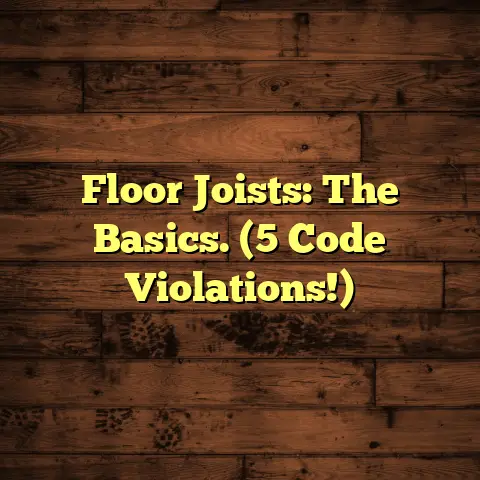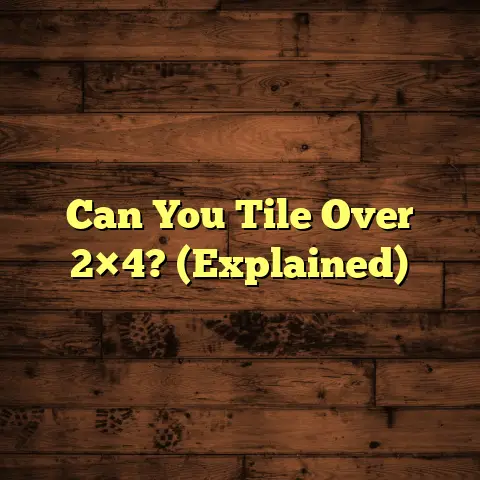Creaky Wood Floors In Winter? (4 Causes Exposed!)
Let’s be honest, that creak… creak… creak underfoot isn’t just an annoyance. It’s your wood floor sending out an SOS, especially during the harsh winter months. I’ve seen it countless times in my years as a flooring contractor – homeowners driven to the brink by the symphony of squeaks. But don’t despair! Understanding why your floors are acting up is the first step to silencing them for good.
Understanding Creaky Wood Floors: More Than Just a Noise
So, what exactly are creaky wood floors? It’s that distinct sound – sometimes a high-pitched squeak, other times a deeper groan – that accompanies your every step. You feel it too, a slight give or movement underfoot.
Beyond the sound, there’s an emotional toll. That constant creaking can be stressful, making your home feel less like a sanctuary and more like a haunted house. I’ve had clients tell me they avoid certain areas of their house just to escape the noise! And let’s not forget the embarrassment when guests are over. Nobody wants their home to sound like a pirate ship in a storm.
But why do wood floors creak in the first place? The simple answer is movement. When wood rubs against other wood or fasteners, it creates that telltale sound. But the reasons for that movement are varied. Today, I will expose the four main culprits behind winter creaks.
Cause 1: Temperature Changes – The Winter Wood Workout
Winter brings dramatic temperature swings. You crank up the heat indoors while the outside temperature plummets. This creates a battleground for your wood floors.
Wood is a hygroscopic material, meaning it readily absorbs and releases moisture from the surrounding air. As the temperature fluctuates, the wood fibers expand and contract. Think of it like this:
-
Warm temperatures: Wood expands, increasing in size.
-
Cold temperatures: Wood contracts, shrinking in size.
Different wood species react differently to temperature changes. For example, wider planks of hardwood flooring, like those made from oak or hickory, tend to be more susceptible to movement than narrower planks or engineered wood.
I’ve seen situations where a homeowner installs solid hardwood in a vacation cabin that’s unheated for long periods in the winter. The extreme temperature drops cause significant shrinkage, leading to large gaps and, you guessed it, a chorus of creaks.
Cause 2: Humidity Levels – The Silent Thief of Moisture
Temperature and humidity are partners in crime when it comes to creaky floors. In the winter, the air becomes incredibly dry, especially when you’re running your heating system. This dry air sucks the moisture out of everything, including your wood floors.
When wood loses moisture, it shrinks. This shrinkage can create gaps between planks, between the flooring and the subfloor, or around fasteners. These gaps allow for movement, and that movement translates to creaks.
Think of it like this: imagine a wooden puzzle. When the pieces are snug, there’s no movement. But if the pieces shrink, gaps appear, and they start to shift and rub against each other.
I once worked on a house where the homeowner had a whole-house humidifier, but it wasn’t properly calibrated. The humidity levels were consistently below 30% in the winter. The result? Severely shrunken floors and creaks that could wake the dead.
Ideal Humidity Levels for Wood Floors:
| Season | Recommended Humidity Level |
|---|---|
| Winter | 30-50% |
| Summer | 30-60% |
Source: National Wood Flooring Association (NWFA)
Maintaining proper humidity levels is crucial for the health of your wood floors. Investing in a good humidifier and monitoring the humidity levels with a hygrometer can save you a lot of headaches (and creaks) down the road.
Cause 3: Improper Installation – The Foundation of Future Problems
Let’s face it, even the best materials can fail if the installation is subpar. I’ve seen countless cases where creaky floors were a direct result of shortcuts taken during installation.
Here are some common installation mistakes that lead to creaky floors:
-
Inadequate nailing/fastening: If the flooring isn’t securely fastened to the subfloor, it will move and creak. Insufficient nailing, using the wrong type of fasteners, or spacing the fasteners too far apart are all common culprits.
-
Poor subfloor preparation: The subfloor is the foundation for your wood flooring. If it’s not level, clean, and properly prepared, the flooring will be uneven and prone to movement.
-
Failure to leave proper expansion gaps: Wood needs room to expand and contract with changes in temperature and humidity. If the flooring is installed too tightly against walls or other fixed objects, it won’t have room to move, leading to stress and creaking.
I remember one particularly frustrating job where the previous contractor had used staples instead of flooring nails to install a beautiful hardwood floor. Within a year, the staples started to loosen, and the entire floor became a creaking nightmare. We had to rip it all up and start from scratch.
Cause 4: Subfloor Issues – The Hidden Culprit
Sometimes, the problem isn’t the wood flooring itself, but the subfloor underneath. The subfloor provides the support and stability that your wood floor needs. If the subfloor is compromised, it can lead to creaking, even if the flooring is properly installed.
Common subfloor issues include:
-
Warping: Warped subfloor panels create uneven surfaces, causing the flooring to flex and creak.
-
Moisture damage: Moisture can weaken the subfloor, causing it to rot or delaminate. This reduces its ability to support the flooring.
-
Inadequate support: If the subfloor isn’t properly supported by joists, it can sag or flex under weight, leading to creaking.
Here’s a simple test: walk around your floor and pay attention to where the creaks are most pronounced. If the creaking is concentrated in certain areas, it could indicate a problem with the subfloor beneath those areas.
I once investigated a creaky floor in an older home and discovered that the subfloor joists had been weakened by termite damage. The homeowner had no idea until we pulled up the flooring. Addressing the termite damage and reinforcing the joists completely eliminated the creaking.
Conclusion: Silence the Squeaks and Protect Your Home
Creaky wood floors in winter are more than just an annoyance; they’re a symptom of underlying issues that need to be addressed. Whether it’s temperature changes, humidity fluctuations, improper installation, or subfloor problems, understanding the cause is the first step to finding a solution.
Ignoring creaky floors can lead to more serious problems down the road. Excessive movement can damage the flooring itself, loosen fasteners, and even compromise the structural integrity of the subfloor.
So, take the time to investigate those creaks. Check your humidity levels, inspect your subfloor (if possible), and consult with a qualified flooring contractor if needed.
Remember, your home is an investment, and your floors are a vital part of that investment. Don’t let those creaks turn into a cry for help that goes unanswered. A quiet floor is a happy floor, and a happy floor makes for a happy home.





